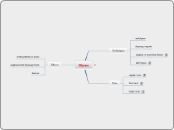Floating topic
Patterns. Patterns can help students connect ideas together and help promote cross disciplinary awareness.
3 Correlation issues with patterns in multiplication
When you start adding negative numbers and you get double negatives turns into a positive and so on.
When you begin teaching division and try to explain it is the opposite of multiplication. And you have to find the amount of times the divider fits into the dividend through multiplication even though you thought you were doing division
when you start adding squared and power ofs and it gets confusing 4^4 is 256 4x4 is 16
2x2 and 2+2 are the same
Undergeneralizations in patterns of Multiplication
Students may have problems with longer multiplication problems like 31x6 and do 3x6=18 and 6x1=6 and add those together and get 24 instead of the real answer of
Overgeneralization of patterns in Multiplication
Students may not understand why multiplication is reciprocal 5x3=3x5
Students may become confused what to do in situations like 0 times a number or a number times 0
Students may get confused why 2x2 and 2+2 have the same answer
Students may get confused with addition and think that it is just 4x6=10 instead of 24
Prototype of the defining features of patterns in Multiplication
2x2=4 2+2=4
8x8=64, 8+8+8+8+8+8+8+8=64
4x4=16, 4+4+4+4=16
Teaching the concept: Patterns in Multiplication
Characteristics in Multiplication
The product is always the answer to the problem. The sum once the multiplicand is added to itself the amount of times the multiplier says it should be.
12X4=48 The 48 is the product
The Multiplier always tells the multiplicand how many times it is repeated
12x4=12+12+12+12=48
The Multiplier is the Second or bottom number. This is the number that states how many times the multiplicand will be added to itself, or multiplied by.
Example of multiplier: 12x4=48 The 4 is the Multiplier
The first or top number in the problem is the multiplicand. This is also the number being added to itself, or multiplied.
Example of Multiplicand 12x4=48. The 12 is the Multiplicand
Patterns in different disciplines
Literature: Patterns of Character traits throughout a story
Science Scientific Methods (Look for patterns to prove or disprove your theory)
Math: Multiplying
Art: The different patterns in mosaics
Students and their needs.
You could make sure that the students are getting every day examples of patterns like 2,4,6,8,10 are all two repeated, or different clapping games so they can create connections to everyday things.
The Piagetian stage that the students are in would be is the concrete operational stage.
Students who like to find connections between things will find this the most enjoyable. However students who struggle to recognize patterns will need deeper instruction









